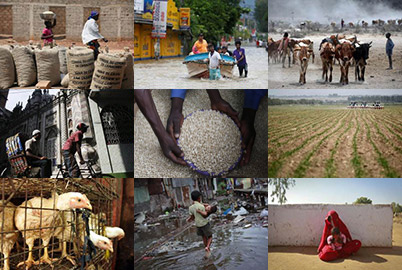Jacques Dolce features in One Day in Port-au-Prince, a multimedia documentary.
PORT-AU-PRINCE (AlertNet) - Squatting by the kerbside on Boulevard Jean-Jacques Dessalines, surrounded by jerry cans and plastic bottles, Jacques Dolce shared his views on how best to help Haiti recover from the earthquake. Never mind aid – what people really need is jobs.
“Everybody in the country would like to work,” he said, echoing a sentiment you hear on street corners and in tent cities all over Port-au-Prince.
Jacques, 42, was a proud working man before the quake: a driver. The disaster destroyed the business, so he created a job for himself, buying and selling petrol by the roadside. His office is a stool in the gutter, where he sits and watches cars, trucks and U.N. armoured vehicles trundle by.
“Sometimes they bring me the gas,” he explained. “I buy it for $20 and sell it back for $22 or $23. I’m trying to get the $3 to have enough to feed my children, provide for their schooling and all other activities.”
Unlike chauffeuring, petrol-dealing is a resilient industry. Everybody needs fuel – to fill the tanks of the heavy vehicles used to clear rubble; to quench the thirst of gas-guzzling U.N. Land Crusiers; and to fire up generators in the camps, for recharging mobile phones or powering ghetto blasters.
The need for petrol was especially acute in the immediate aftermath of the earthquake. For a week or so, fuel was like gold. The entire relief effort depended on it – for everything from delivering food to purifying water. And many of the newly homeless, desperate to get out of Port-au-Prince, needed it for their cars.
For a day or two, lines at petrol stations stretched around the block as people waited for hours in the sun to fill jerry cans. Then, abruptly, the forecourts were empty.
Until fuel tankers started coming in from across the border in Dominican Republic, the shortage hit everyone. Prices on the black market jumped as high as $200 a gallon, according to some reports.
“We weren’t able to work (as drivers) because everybody was moving,” Jacques recalled. “The cars couldn’t circulate. A few (of our) cars went to the countryside, and we gave up. We had no gas.”
Most of the 600,000 or so Haitians who fled the capital right after the quake are thought to have since returned. The countryside just doesn’t have the jobs, infrastructure, food or housing to support such an exodus.
These days, it’s business as usual at the capital’s petrol stations. If anything will stop you getting from point A to B, it’s not lack of fuel but the sheer number of cars on the road. A journey of a couple of miles can take three hours.
Meanwhile, street-side vendors like Jacques offer motorists a slight discount from the official prices at the big petrol pumps.
“Now I have to keep on working with this, but I know that some day, somehow, the country will change so that all the young ones can find work … I’d like to get out of this situation, to not be selling gas in the street. I’d like to have my licence to be able to work, to drive, whether it’s foreigners or Haitians, to find work the way it should be.”

